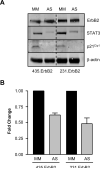ErbB2-mediated Src and signal transducer and activator of transcription 3 activation leads to transcriptional up-regulation of p21Cip1 and chemoresistance in breast cancer cells
- PMID: 19372587
- PMCID: PMC2689096
- DOI: 10.1158/1541-7786.MCR-08-0316
ErbB2-mediated Src and signal transducer and activator of transcription 3 activation leads to transcriptional up-regulation of p21Cip1 and chemoresistance in breast cancer cells
Abstract
Overexpression of the ErbB2 receptor tyrosine kinase is prevalent in approximately 30% of human breast cancers and confers Taxol resistance. Our previous work has shown that ErbB2 inhibits Taxol-induced apoptosis in breast cancer cells by transcriptionally up-regulating p21(Cip1). However, the mechanism of ErbB2-mediated p21(Cip1) up-regulation is unclear. Here, we show that ErbB2 up-regulates p21(Cip1) transcription through increased Src activity in ErbB2-overexpressing cells. Src activation further activated signal transducer and activator of transcription 3 (STAT3) that recognizes a SIE binding site on the p21(Cip1) promoter required for ErbB2-mediated p21(Cip1) transcriptional up-regulation. Both Src and STAT3 inhibitors restored Taxol sensitivity in resistant ErbB2-overexpressing breast cancer cells. Our data suggest that ErbB2 overexpression can activate STAT3 through Src leading to transcriptional up-regulation of p21(Cip1) that confers Taxol resistance of breast cancer cells. Our study suggests a potential clinical application of Src and STAT3 inhibitors in Taxol sensitization of ErbB2-overexpressing breast cancers.
Figures






Similar articles
-
ErbB2 overexpression in human breast carcinoma is correlated with p21Cip1 up-regulation and tyrosine-15 hyperphosphorylation of p34Cdc2: poor responsiveness to chemotherapy with cyclophoshamide methotrexate, and 5-fluorouracil is associated with Erb2 overexpression and with p21Cip1 overexpression.Cancer. 2003 Sep 15;98(6):1123-30. doi: 10.1002/cncr.11625. Cancer. 2003. PMID: 12973835
-
Progestin drives breast cancer growth by inducing p21(CIP1) expression through the assembly of a transcriptional complex among Stat3, progesterone receptor and ErbB-2.Steroids. 2013 Jun;78(6):559-67. doi: 10.1016/j.steroids.2012.11.003. Epub 2012 Nov 21. Steroids. 2013. PMID: 23178160
-
Enhanced sensitization to taxol-induced apoptosis by herceptin pretreatment in ErbB2-overexpressing breast cancer cells.Cancer Res. 2002 Oct 15;62(20):5703-10. Cancer Res. 2002. PMID: 12384528
-
NUPR1 interacts with p53, transcriptionally regulates p21 and rescues breast epithelial cells from doxorubicin-induced genotoxic stress.Curr Cancer Drug Targets. 2008 Aug;8(5):421-30. doi: 10.2174/156800908785133196. Curr Cancer Drug Targets. 2008. PMID: 18690848
-
Mechanisms of ErbB2-mediated paclitaxel resistance and trastuzumab-mediated paclitaxel sensitization in ErbB2-overexpressing breast cancers.Semin Oncol. 2001 Oct;28(5 Suppl 16):12-7. doi: 10.1016/s0093-7754(01)90277-5. Semin Oncol. 2001. PMID: 11706391 Review.
Cited by
-
Kinase shRNA screening reveals that TAOK3 enhances microtubule-targeted drug resistance of breast cancer cells via the NF-κB signaling pathway.Cell Commun Signal. 2020 Oct 21;18(1):164. doi: 10.1186/s12964-020-00600-2. Cell Commun Signal. 2020. PMID: 33087151 Free PMC article.
-
NCAPG confers trastuzumab resistance via activating SRC/STAT3 signaling pathway in HER2-positive breast cancer.Cell Death Dis. 2020 Jul 18;11(7):547. doi: 10.1038/s41419-020-02753-x. Cell Death Dis. 2020. PMID: 32683421 Free PMC article.
-
Involvement of extracellular signal-regulated kinase (ERK1/2)-p53-p21 axis in mediating neural stem/progenitor cell cycle arrest in co-morbid HIV-drug abuse exposure.J Neuroimmune Pharmacol. 2014 Jun;9(3):340-53. doi: 10.1007/s11481-014-9523-7. Epub 2014 Jan 28. J Neuroimmune Pharmacol. 2014. PMID: 24469921
-
Polypharmacology-based kinome screen identifies new regulators of KSHV reactivation.PLoS Pathog. 2023 Sep 5;19(9):e1011169. doi: 10.1371/journal.ppat.1011169. eCollection 2023 Sep. PLoS Pathog. 2023. PMID: 37669313 Free PMC article.
-
Upregulation of neutrophil gelatinase-associated lipocalin by ErbB2 through nuclear factor-kappaB activation.Cancer Res. 2009 Dec 15;69(24):9163-8. doi: 10.1158/0008-5472.CAN-09-2483. Cancer Res. 2009. PMID: 19951994 Free PMC article.
References
-
- Yu D, Hung MC. Role of erbB2 in breast cancer chemosensitivity. Bioessays. 2000;22(7):673–80. - PubMed
-
- Slamon DJ, Godolphin W, Jones LA, et al. Studies of the HER-2/neu protooncogene in human breast and ovarian cancer. Science. 1989;244(4905):707–12. - PubMed
-
- Witters LM, Santala SM, Engle L, Chinchilli V, Lipton A. Decreased response to paclitaxel versus docetaxel in HER-2/neu transfected human breast cancer cells. Am J Clin Oncol. 2003;26(1):50–4. - PubMed
-
- Yu D, Liu B, Jing T, et al. Overexpression of both p185c-erbB2 and p170mdr-1 renders breast cancer cells highly resistant to taxol. Oncogene. 1998;16(16):2087–94. - PubMed
-
- Tan M, Jing T, Lan KH, et al. Phosphorylation on tyrosine-15 of p34(Cdc2) by ErbB2 inhibits p34(Cdc2) activation and is involved in resistance to taxol-induced apoptosis. Mol Cell. 2002;9(5):993–1004. - PubMed
Publication types
MeSH terms
Substances
Grants and funding
LinkOut - more resources
Full Text Sources
Other Literature Sources
Medical
Molecular Biology Databases
Research Materials
Miscellaneous

